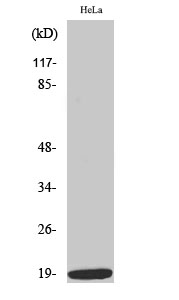Phospho Stathmin 1 (S15) Cell-Based Colorimetric ELISA Kit
- Catalog No.:KA1658C
- Applications:ELISA
- Reactivity:Human;Mouse;Rat
- Gene Name:
- STMN1
- Human Gene Id:
- 3925
- Human Swiss Prot No:
- P16949
- Mouse Swiss Prot No:
- P54227
- Rat Swiss Prot No:
- P13668
- Storage Stability:
- 2-8°C/6 months
- Other Name:
- Stathmin (Leukemia-associated phosphoprotein p18) (Metablastin) (Oncoprotein 18) (Op18) (Phosphoprotein p19) (pp19) (Prosolin) (Protein Pr22) (pp17)
- Detection Method:
- Colorimetric
- Background:
- disease:Present in much greater abundance in cells from patients with acute leukemia of different subtypes than in normal peripheral blood lymphocytes, non-leukemic proliferating lymphoid cells, bone marrow cells, or cells from patients with chronic lymphoid or myeloid leukemia.,function:Involved in the regulation of the microtubule (MT) filament system by destabilizing microtubules. Prevents assembly and promotes disassembly of microtubules. Phosphorylation at Ser-16 may be required for axon formation during neurogenesis. Involved in the control of the learned and innate fear.,PTM:Many different phosphorylated forms are observed depending on specific combinations among the sites which can be phosphorylated. MAPK is responsible for the phosphorylation of stathmin in response to NGF. Phosphorylation at Ser-16 seems to be required for neuron polarization (By similarity). Phosphorylation at Ser-63 reduces tubulin binding 10-fold and suppresses the MT polymerization inhibition activity.,similarity:Belongs to the stathmin family.,subunit:Binds to two alpha/beta-tubulin heterodimers. Interacts with KIST.,tissue specificity:Ubiquitous. Expression is strongest in fetal and adult brain, spinal cord, and cerebellum, followed by thymus, bone marrow, testis, and fetal liver. Expression is intermediate in colon, ovary, placenta, uterus, and trachea, and is readily detected at substantially lower levels in all other tissues examined. Lowest expression is found in adult liver.,
- Function:
- microtubule cytoskeleton organization, mitotic cell cycle, M phase, cytoskeleton organization, microtubule-based process, microtubule depolymerization, cell cycle, spindle organization, mitotic spindle organization, intracellular signaling cascade, cell cycle process, cell cycle phase, cellular component disassembly, microtubule polymerization or depolymerization, macromolecular complex disassembly, cellular macromolecular complex subunit organization, cellular macromolecular complex disassembly, protein complex disassembly, cellular protein complex disassembly,macromolecular complex subunit organization, protein depolymerization,
- Subcellular Location:
- Cytoplasm, cytoskeleton.
- Expression:
- Ubiquitous. Expression is strongest in fetal and adult brain, spinal cord, and cerebellum, followed by thymus, bone marrow, testis, and fetal liver. Expression is intermediate in colon, ovary, placenta, uterus, and trachea, and is readily detected at substantially lower levels in all other tissues examined. Lowest expression is found in adult liver. Present in much greater abundance in cells from patients with acute leukemia of different subtypes than in normal peripheral blood lymphocytes, non-leukemic proliferating lymphoid cells, bone marrow cells, or cells from patients with chronic lymphoid or myeloid leukemia.
- June 19-2018
- WESTERN IMMUNOBLOTTING PROTOCOL
- June 19-2018
- IMMUNOHISTOCHEMISTRY-PARAFFIN PROTOCOL
- June 19-2018
- IMMUNOFLUORESCENCE PROTOCOL
- September 08-2020
- FLOW-CYTOMEYRT-PROTOCOL
- May 20-2022
- Cell-Based ELISA│解您多样本WB检测之困扰
- July 13-2018
- CELL-BASED-ELISA-PROTOCOL-FOR-ACETYL-PROTEIN
- July 13-2018
- CELL-BASED-ELISA-PROTOCOL-FOR-PHOSPHO-PROTEIN
- July 13-2018
- Antibody-FAQs


